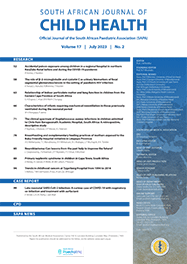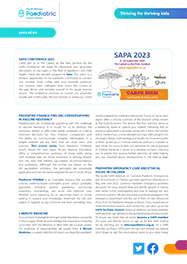Research

Blood pressure pattern and the relationship with body mass index among apparently healthy secondaryschool students in Sokoto metropolis, Nigeria
Abstract
Background. Childhood obesity may result in the premature onset of cardiovascular risk factors, particularly hypertension, hence the need for proper screening. However, blood pressure (BP) is measured only once in most studies in Nigeria, probably because of difficulties in returning to the study areas for repeat measurement.
Objective. To determine the BP pattern and assess its relationship with body mass index (BMI) in apparently healthy secondary-school students aged 10 - 18 years in Sokoto metropolis, Nigeria.
Methods. This study was descriptive and cross-sectional, and carried out between 13 October 2014 and 30 January 2015. In total, 800 students from 6 schools were selected through multistage sampling. BP was measured on three separate days according to the National High Blood Pressure Education Program charts. BMI was categorised according to the Centers for Disease Control charts. The relationship of BP level with BMI was determined.
Results. There were 424 (53.0%) males and 376 (47.0%) females, with a ratio of approximately 1:1. BP increased with age. The mean systolic and diastolic BP was significantly higher in females than males (systolic 113.1 mmHg v. 110.5 mmHg, and diastolic 69.0 mmHg v. 66.5 mmHg, respectively; p=0.01). Females had a higher mean BMI than males (18.7 kg/m2 v. 17.9 kg/m2, respectively; p<0.01). BP increased as the BMI percentile increased (p<0.001). The prevalence rates of hypertension were 6.1%, 3.5% and 3.1% at the first, second and third screenings, respectively, while the corresponding prevalence rates of prehypertension were 14.3%, 8.4% and 7.1%. The prevalence of obesity and overweight was 0.3% and 5.9%, respectively.
Conclusion. The prevalence rate of prehypertension and hypertension reduced with subsequent measurements, and the prevalence rates of overweight and obesity were low. However, higher BP levels were associated with higher BMI, supporting its predictive significance for elevated BP.
Authors' affiliations
K O Isezuo, Department of Paediatrics, Usmanu Danfodiyo University Teaching Hospital, Sokoto, Nigeria
N M Jiya, Department of Paediatrics, Usmanu Danfodiyo University Teaching Hospital, Sokoto, Nigeria
L I Audu, Department of Paediatrics, National Hospital, FCT Abuja, Nigeria
P K Ibitoye, Department of Paediatrics, Usmanu Danfodiyo University Teaching Hospital, Sokoto, Nigeria
U M Sani, Department of Paediatrics, Usmanu Danfodiyo University Teaching Hospital, Sokoto, Nigeria
T Yusuf, Department of Paediatrics, Usmanu Danfodiyo University Teaching Hospital, Sokoto, Nigeria
B I Garba, Department of Paediatrics, Usmanu Danfodiyo University Teaching Hospital, Sokoto, Nigeria
A Adamu, Department of Paediatrics, Usmanu Danfodiyo University Teaching Hospital, Sokoto, Nigeria
F B Jiya, Department of Paediatrics, Usmanu Danfodiyo University Teaching Hospital, Sokoto, Nigeria
Full Text
Cite this article
Article History
Date published: 2018-09-28
Article Views
Full text views: 1079

.jpg)



Comments on this article
*Read our policy for posting comments here